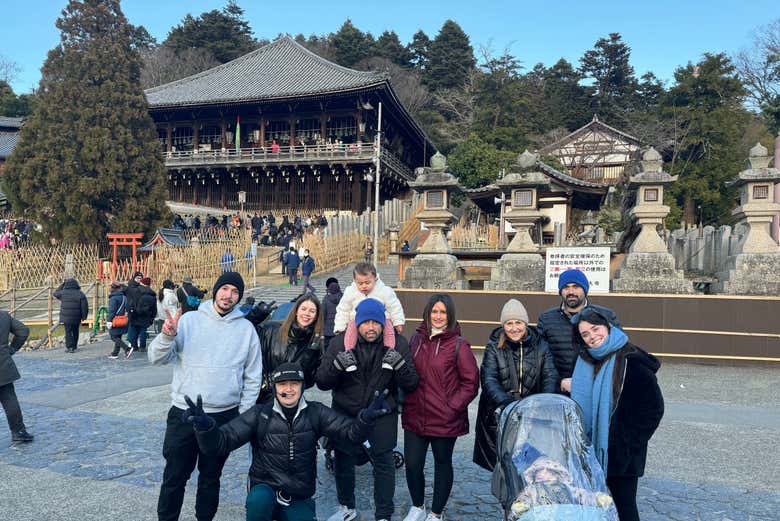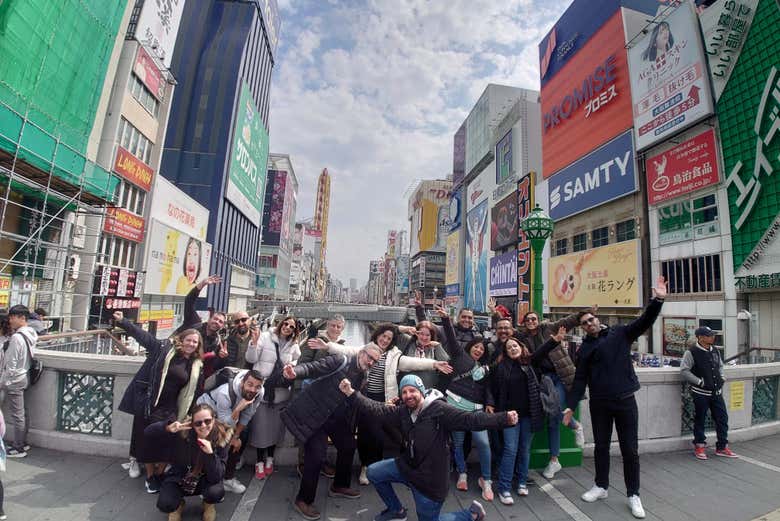Free Walking Sightseeing Tours in Nara, Japan
Legend
Self-guided Tours
Paid Tours & Activities
Guided Free Walking Tours
Book free guided walking tours in Nara.
Guided Sightseeing Tours
Book guided sightseeing tours and activities in Nara.
Are you ready for an unforgettable time in Nara, Japan? Then you've come to the right place with our sightseeing tours. Whether you prefer a guided free walking tour with insider knowledge or enjoy the freedom of a self-guided route, you'll find exactly what you're looking for. Click on a tour and find out more about the highlights that await you!
Activities in NaraIndividual Sights in Nara 0$
English
English
2h 30m
9.3/10 stars, 67 ratings
9.3/10 stars, 67 ratings
Join us on a journey through time in our free tour of Nara, and explore ancient Japan while visiting some of the nation's most significant shrines and temples.
Show on Civitatis* 0$
English
English
2h 30m
9.1/10 stars, 385 ratings
9.1/10 stars, 385 ratings
Join us for a free tour of Osaka as we delve into the charms and most significant sites of one of Japan's largest and most vibrant cities!
Show on Civitatis* 19 sights
2.7 km
2.7 km
36 m
23 m
23 m
- 一心山 称念寺
- 誕生寺
- 徳融寺
- 元興寺小塔院跡
- 小塔院
- 紫雲山 西光院
- Naramachi Museum
- 率川神社
- 白山神社
- 南都御霊神社
- 豊成山高坊高林寺
- 正覚寺
- 法徳寺
- 金躰寺
- Jurin-in Temple
- 興善寺
- 今西家書院
- Fukuchi-in Temple
- 鎧地蔵堂
38 sights
9.3 km
9.3 km
186 m
121 m
121 m
- 京終地蔵院
- 飛鳥神社(京終天神社)
- 椚神社
- 春日若宮社
- 井上神社
- 正覚寺
- 豊成山高坊高林寺
- 誕生寺
- 徳融寺
- 元興寺小塔院跡
- 小塔院
- 白山神社
- 率川神社
- Naramachi Museum
- 住吉神社
- 南都御霊神社
- 法徳寺
- 金躰寺
- Jurin-in Temple
- 興善寺
- 今西家書院
- 名勝大乗院庭園文化館
- Yuga Shrine
- Naramachi Ten-jinja Shrine
- Fukuchi-in Temple
- 鎧地蔵堂
- Zuto Tower
- Kibizuka Tomb
- 閼伽井庵
- Ako Shrine
- 奈良学園セミナーハウス志賀直哉旧居
- Kasuga-taisha
- 不空院 (Fukūin)
- Himegamisha Shrine
- Shin Yakushi-ji Temple
- Kagami Shrine
- Irie Taikichi Memorial Museum of Photography Nara City
- 隔夜寺
9 sights
2.4 km
2.4 km
48 m
44 m
44 m
- Kibizuka Tomb
- 閼伽井庵
- Ako Shrine
- Irie Taikichi Memorial Museum of Photography Nara City
- Kagami Shrine
- Shin Yakushi-ji Temple
- Himegamisha Shrine
- 不空院 (Fukūin)
- Kasuga-taisha
19 sights
5.2 km
5.2 km
127 m
78 m
78 m
- 一心山 称念寺
- 徳融寺
- 紫雲山 西光院
- Chintakureifu Shrine
- 細川家住宅
- 森家住宅
- 十念寺
- 暁光山 正覺寺
- 猿田彦神社 (道祖神)
- Uneme Shrine
- Nara Episcopal Church
- 手力雄神社
- Kōfuku-ji
- National Treasure Museum
- 菩提院大御堂(十三鐘)
- Nara National Museum
- Buddhist Art Library
- Kasuga-taisha
- Manyo Botanical Garden
16 sights
4.4 km
4.4 km
72 m
101 m
101 m
- Tōdai-ji
- Nara National Museum
- Buddhist Art Library
- Zuto Tower
- Naramachi Ten-jinja Shrine
- Yuga Shrine
- Daijo-in Japanese Garden
- Fukuchi-in Temple
- 今西家書院
- Gangō-ji
- 住吉神社
- 暁光山 正覺寺
- 十念寺
- 森家住宅
- 細川家住宅
- Chintakureifu Shrine
23 sights
6.8 km
6.8 km
135 m
137 m
137 m
- Kango Shrine
- Emperor Kaika’s Kasuga-no-Izakawa-no-Sakanoe-no-Misasagi Tomb
- 念仏寺
- 西照寺
- 住吉神社
- 月日神社
- 淨教寺
- Isagawa Shrine
- 常徳寺
- 伝香寺
- Nara Episcopal Church
- 手力雄神社
- Uneme Shrine
- 猿田彦神社 (道祖神)
- Kōfuku-ji
- National Treasure Museum
- 菩提院大御堂(十三鐘)
- Himuro Shrine
- Yoshiki Garden
- Isui Garden
- 寧楽美術館
- Irie Taikichi's old residence
- 祇園社八阪神社
9 sights
3.9 km
3.9 km
97 m
30 m
30 m
- Shomyoji
- やくよけ観音寺 慈眼寺(jiganji)
- 祇園社八阪神社
- Nara Prefectural Museum of Art
- Isui Garden
- 寧楽美術館
- Irie Taikichi's old residence
- Tōdai-ji
- Tamukeyama Hachiman Shrine
7 sights
3.5 km
3.5 km
64 m
35 m
35 m
- Renchō-ji Temple
- 勝手神社
- Shomyoji
- やくよけ観音寺 慈眼寺(jiganji)
- Nara Prefectural Museum of Art
- 子規の庭
- Tōdai-ji
5 sights
2.5 km
2.5 km
28 m
44 m
44 m
- 佐紀石塚山古墳
- 佐紀陵山古墳
- Saki Shrine
- Nara Palace Historical Park
- Tomb of Emperor Heijo
Share
Spread the word! Share this page with your friends and family.
How likely are you to recommend us?
What can we improve?
Why Visit Sights? Self-guided sightseeing tours are a free and safe alternative to bus tours. You can explore Nara at your own pace, any time! Do something good for your health by walking.

